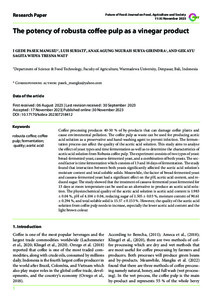| dc.date.accessioned | 2023-12-15T14:26:14Z | |
| dc.date.available | 2023-12-15T14:26:14Z | |
| dc.date.issued | 2023-11-30 | |
| dc.identifier | doi:10.17170/kobra-202307218412 | |
| dc.identifier.uri | http://hdl.handle.net/123456789/15305 | |
| dc.language.iso | eng | |
| dc.rights | Namensnennung 4.0 International | * |
| dc.rights.uri | http://creativecommons.org/licenses/by/4.0/ | * |
| dc.subject | robusta coffee | eng |
| dc.subject | coffee pulp | eng |
| dc.subject | fermentation | eng |
| dc.subject | quality | eng |
| dc.subject | acetic acid | eng |
| dc.subject.ddc | 300 | |
| dc.subject.ddc | 500 | |
| dc.title | The potency of robusta coffee pulp as a vinegar product | eng |
| dc.type | Aufsatz | |
| dcterms.abstract | Coffee processing produces 40-50 % of by-products that can damage coffee plants and cause environmental pollution. The coffee pulp as waste can be used for producing acetic acid solution as a preservative and hand-washing agent to prevent infection. The fermentation process can affect the quality of the acetic acid solution. This study aims to analyse the effect of yeast types and time fermentation as well as to determine the characteristics of acetic acid solution from Robusta coffee pulp. The experiment consists of two types of yeast: bread-fermented yeast, cassava-fermented yeast, and a combination of both yeasts. The second factor is time fermentation which consists of 13 and 16 days of fermentation. The study found that interaction between both yeasts significantly affected the acetic acid solution's moisture content and total soluble solids. Meanwhile, the factor of bread-fermented yeast and cassava-fermented yeast had a significant effect on the pH, acetic acid content, and reduced sugar. The study showed that the treatment of cassava-fermented yeast fermented for 13 days at room temperature can be used as an alternative to produce an acetic acid solution. The physicochemical quality of the acetic acid solution is acetic acid content is 1.983 ± 0.04 %, pH of 4.104 ± 0.04, reducing sugar of 1.505 ± 0.03 %, moisture content of 90.61 ± 0.294 %, and total soluble solid is 15.57 ± 0.153 %. However, the quality of the acetic acid solution from coffee pulp needs to increase, especially the lower acetic acid content and the light brown colour. | eng |
| dcterms.accessRights | open access | |
| dcterms.creator | Mangku, I Gede Pasek | |
| dcterms.creator | Suriatt, Luh | |
| dcterms.creator | Girindra, Anak Agung Ngurah Surya | |
| dcterms.creator | Wati, Gek Ayu Sagita Widya Tresna | |
| dc.subject.swd | Robusta-Kaffee | ger |
| dc.subject.swd | Halbstoff | ger |
| dc.subject.swd | Fermentation | ger |
| dc.subject.swd | Lebensmittelqualität | ger |
| dc.subject.swd | Essigsäure | ger |
| dc.type.version | publishedVersion | |
| dcterms.source.identifier | eissn:2197-411X | |
| dcterms.source.issue | No. 4 | |
| dcterms.source.journal | Future of Food: Journal on Food, Agriculture & Society | eng |
| dcterms.source.volume | Vol. 11 | |
| kup.iskup | false | |
| dcterms.source.articlenumber | 652 | |


